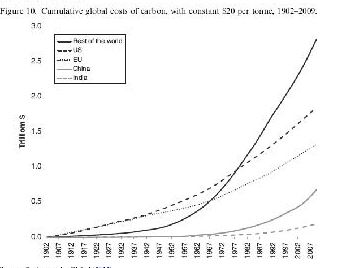Also discussed here: Who is responsible for climate change? (Science Daily, Jul. 4, 2014)
Today we review a very basic look at the cost of the carbon emitting countries not taking action earlier to reduce emissions to keep the accumulated atmospheric CO2 below a “safe” level of 350 ppm. The current level has just exceeded 400 ppm and the objective is to keep it below 450 ppm. The cumulative costs from 1902 to 2007, apportioned by emission source are estimated at over $6 trillion for the US, just over $4 trillion for the EU with China’s share rapidly climbing to just under $4 trillion. The costs in terms of climate impacts are felt by most if not all countries with the cost of refugees forced to emigrate by climate warming for example expected to increase eight fold to 200 million. The authors recommend the setting of a fixed carbon tax of $50/ton to account for this which balances the excess emission on the past when impacts were not as severe with the much greater impacts that result from excessive emissions recently.

Key Quotes:
“The long half-life of the greenhouse gases means global warming is influenced by emissions accumulated over past centuries. Thus, past polluters owe a ‘carbon debt’ to the future generations…pollution from fossil fuels has both immediate flow and long-lasting cumulative stock effects on local, regional and global scales.”
“A carbon dioxide threshold of 350 parts per million (ppm) is generally considered the ‘safe’ level.9 This threshold has already been surpassed and the seasonally adjusted annual figure is estimated to reach 400 ppm in the spring of 2014 or 2015. The often mentioned 450 ppm target is a political compromise between risks and the costs of emission reductions”
“the commonly cited estimate …of 200 million people displaced when global warming takes hold could easily be exceeded. Even this estimate would mean an eight-fold increase over today’s entire documented refugee and internally displaced populations.”“the social cost of carbon (SCC), the monetised value of the marginal benefit of reducing one tonne of CO2 measured by its carbon content. This is determined by the marginal value of avoided damages…Using standard assumptions about discounting and aggregation, the marginal damage costs of carbon dioxide emissions are unlikely to exceed $50/tC (31.7 £/tC), and are probably much smaller”
“a ton of CO2 added to an already large stock of atmospheric CO2 is likely to cause a higher damage than a ton emitted under a low concentration level”
“the USA has the highest cumulative cost of carbon emissions during the period 1902 -- 2009, contributing 24-27% of the cumulative global cost, followed by the EU with 17-19%. China is nowadays the biggest source of carbon dioxide, but the cumulative costs of its emissions are still long behind with 10-12%...41-47% of the costs are due to the cumulative emissions of carbon dioxide from the USA and the EU alone”








No comments:
Post a Comment